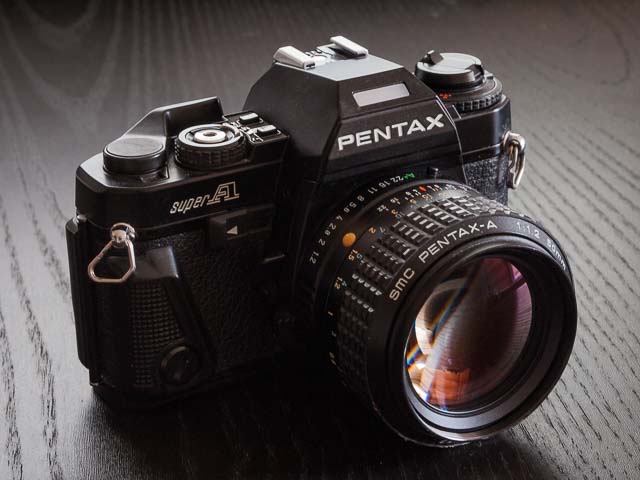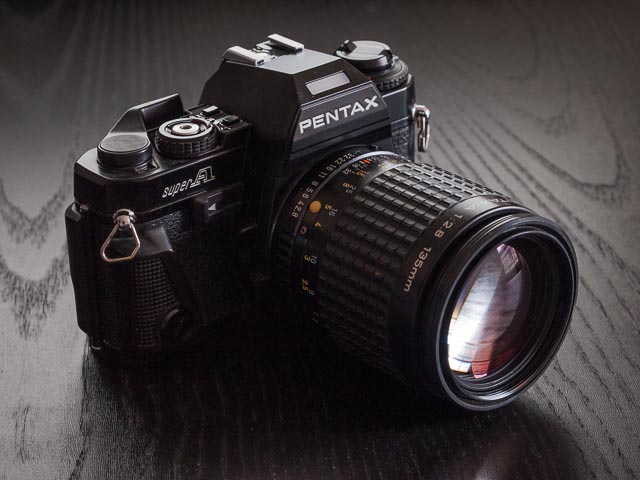Pentax Super A

The Pentax Super A (known as the Pentax Super Program in some markets) was introduced in 1983 at the top of Pentax’s line of consumer level SLRs. It was a multi-mode camera with fully automatic programmed, aperture priority and shutter priority automatic exposure modes along side a manual exposure mode. It also featured automatic flash modes with TTL flash metering. It was designed to compete with a growing range of 1980s multi-mode cameras such as the Minolta XD-7 and Canon A1, Fujica AX5 and Mamiya ZE-X.
To support all these automatic exposure modes, Pentax modified their venerable ‘K’ bayonet lens mount to become the ‘KA’ mount. The new mount features electronic contacts to allow the camera to control the aperture, and the all important ‘A’ (for automatic) setting on the aperture ring.
Like the ME Super before it, the Super A used push buttons to set shutter speed, but it improved on the ME Super by having an LCD on the top plate so you didn’t have to have you eye to the viewfinder to see what shutter speed you were setting. The ME Super and the Super A made doing without a shutter speed dial revolutionary, but Pentax’s push button system proved to be something of a blind alley that was never universally popular. When Canon launched their T90 model in 1986 with an electronic control wheel for setting shutter speed, aperture and other settings, a pattern was set that pretty much the whole camera industry (including eventually Pentax) was to follow. But the Pentax Super A is never-the-less a very nice and compact alternative to the other multi-mode SLRs of the time.
I bought the SMC Pentax-A 50mm f/1.2 lens you can see mounted on my Super A a while before I bought the camera itself. Pentax A series lenses might be over 30 years old, but they still provide full compatibility with the all the exposure modes of modern digital Pentax SLRs (though not of course auto-focus), and it was to use on my K-7 that I bought the 50mm f/1.2. But I thought it would be nice to have a contemporary film camera to go with it, hence the Super A.
My Pentax Super A system
SMC Pentax-A 50mm f/1.2


SMC Pentax-A 135mm f/2.8


SMC Pentax-A 28-80mm f/3.5-4.5


A tale of two cities lenses…
Pentax produced two A series 28-80mm lenses which might appear at first glance to have the same specification.
The first was the Pentax-A 28-80mm f/3.5-4.5. This lens was effectively the 'kit' lens for Pentax's budget orientated P series cameras and it has styling that is quite different to Pentax's main-stream SMC A series lenses. It is very common… almost 10 a penny on eBay!
The lens shown here is the SMC Pentax-A 28-80mm f/3.5-4.5. Note the 'SMC' in the model name (which means it has Pentax's superior 'super multi-coating') and the styling which matches Pentax's other A series lenses. It also has a more complex lens formula than the non-SMC lens (12 elements in 9 groups compared to 8 elements in 8 groups) and is considerably smaller and lighter (355 grams compared to 456 grams).
It is quite a rare lens (Bojidar Dimitrov’s Pentax K-mount website rates availability as ‘used, once in several years’). Rare doesn't necessarily mean valuable though… I paid about £30 on eBay!
Photographs taken with the Pentax Super A
These photographs were all taken at Royal Botanic Garden Edinburgh on Kodak Portra 160 using the SMC Pentax-A 50mm f/1.2 lens.








Photographs taken with the SMC Pentax-A 50mm f/1.2 on a Pentax K-3ii





